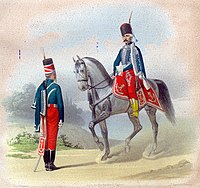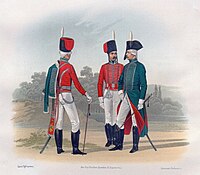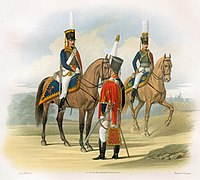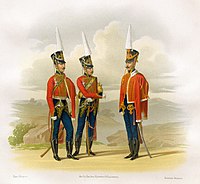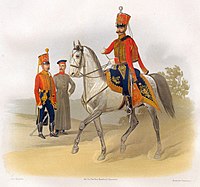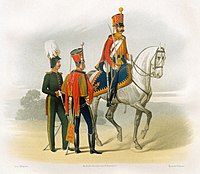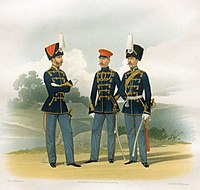|
His Majesty's Hussar Life Guards Regiment
  His Majesty's Life Guards Hussar Regiment (until 1855 – the Hussar Life Guards Regiment) was a Guards Hussar regiment of the Army of the Russian Empire. Organizational stages of the regiment's existenceAt the end of 1774, Empress Catherine II ordered Prince Grigory Potemkin to form a hussar squadron of 130 people and two Cossack escort teams for service under Her Majesty; the squadron was named Leib Gusarsky, and the Cossack teams: one – Donskoy, the other – Chuguevskaya, and ordered to be at the highest court. In April 1775, the squadron was made up of Black (64 people), Yellow (25 people), Serbian (20 people), Moldavian (25 people), Wallachian (11 people) and Hungarian (two people) hussar regiments and was replenished with volunteers from the nobles, the best men of the army regiments and foreigners of beautiful appearance and tall stature. The contingent had to be made up of the best appearance and "living creatures", as well as honest and sober people.[2] Throughout the reign of Catherine II, the squadron and escort teams carried the protection of Her Majesty. On November 18, 1796, from the Life Hussar Squadron, the Cossack escort teams and the Hussar regiment and the Cossack squadron that were part of the Gatchina troops, a Consolidated Life Hussar Cossack Regiment was formed with the rights and advantages of the old guard. The regiment had 2 hussars and 2 cossack squadrons. On April 15, 1797, the 3rd Hussar Squadron was formed. On January 24, 1798, the Life Hussar Cossack Regiment was divided into 2 regiments: the hussar squadrons made up the Life Guards Hussar Regiment, and the Cossack ones – the Life Guards Cossack Regiment. On September 9, 1798, the Life Guards Hussar Regiment was reorganized into 2 battalions of 5 squadrons. Upon the accession to the throne of Emperor Alexander I, the regiment was reorganized on December 29, 1802, into 5 squadrons and occupied the barracks in Krasnoe Selo and Pavlovsk. On January 6, 1813, the regiment was reorganized into 6 active and 1 reserve squadrons. Upon returning to Russia from a foreign campaign in 1814, the Life Hussars settled in Tsarskoe Selo, and the reserve squadron was abolished. On April 22, 1818, Grand Duke Alexander Nikolaevich (later Emperor Alexander II) was appointed chief of the Life Guards Hussar Regiment. On April 6, 1836, the 7th Reserve Squadron was formed from the indefinite vacation of the lower ranks, and on January 25, 1842, it was ordered to have a frame for the 8th Reserve Squadron. In 1848, the 7th Reserve Squadron was named and the 8th Reserve Squadron was formed. On February 19, 1855, on the occasion of the accession to the throne of Emperor Alexander II, who had been the chief of the regiment since 1818, the regiment was ordered to be called His Majesty's Life Guards Hussar Regiment. In 1856, His Majesty's Life Guards Hussar Regiment was assigned to 4 active and 1 reserve squadrons. On July 27, 1875, the reserve squadron was renamed. During the reign of Emperor Alexander III, on August 6, 1883, the regiment was transferred to the 6–squadron, and the reserve squadron was reorganized into the Cadre Department of the Guards Cavalry Reserve. On March 4, 1917, the regiment was renamed the Life Guards Hussar Regiment, and on May 8, 1918, it was disbanded. During the Civil War, the regiment was revived in the Armed Forces of the South of Russia. Initially, the squadron of the regiment was part of the Consolidated Mountain Division. From December 30, 1919, the platoon and squadron of the regiment was included in the Consolidated Cavalry Brigade, from the beginning of January 1920 – in the Consolidated Guards Cavalry Regiment of the 1st Cavalry Division, and upon arrival in the Crimea from April 16, 1920, the Life Hussars formed a platoon of the Guards Cavalry Brigade. In the White movement, the regiment lost 10 officers (two were shot, 7 killed and one died of disease).[3] In emigration, in France, a regimental association was created, which was part of the Russian General Military Union not directly, but only as a member of the Guards Association. In 1949–1951, the association numbered 26 people (including 18 in Paris and two in the United States), in 1958 – 21 people (including 13 in Paris), by 1962 – less than 10 people. Major General Dmitry Levshin and Major General Georgy Shevich were the chairmen of the association of the Life Guards Hussar Regiment.[3] Participation in hostilitiesNapoleonic Wars The regiment took part in the Napoleonic Wars. On June 2, 1807, the regiment distinguished itself near Friedland, where the Russian army, nevertheless, suffered one of the most crushing defeats.
On August 26, 1812, the regiment as part of the 1st Cavalry Corps of General Fyodor Uvarov distinguished itself in the Battle of Borodino.
Russian–Turkish Wars  The regiment took part in the Russian–Turkish Wars.
The first successes of the Russian Army, crossing the Danube, the capture of the cities of Nikopol and Tyrnov, but defeats occurred on our right flank when Osman Pasha moved from the city of Viddin to Plevna and fell on the Russian troops. Before the arrival of reinforcements, the Russian Army went on the defensive, and on July 22, 1877, the mobilization of a part of the Guard was announced, including the 2nd Guards Cavalry Division, which included His Majesty's Life Guards Hussar Regiment. The troops were sent in echelons by rail to the Zhmerynka Station, where the gathering point for arriving reinforcements was located. Arriving on August 20 at the Romanian border, the entire division lined up for a review carried out by the Chief of the Division, Major General Gurko. On August 24, General Gurko, at the head of his division, crossed the Prut River into Turkish territory and followed forced marches to the Danube River. Passing Rymnik and Focsani, recalling the glorious campaigns of the times of Suvorov and Dibich, passing through Bucharest, the regiment arrived at Yaimnitsa on the banks of the Danube on September 11. Crossing the Danube, the Russian Army headed through Bulgaria and on September 17, the Division stopped at Gorny–Studna, where the main apartment of the Sovereign Emperor was, who inspected the arriving troops. The current Russian Army under the High Command of Grand Duke Nikolai Nikolaevich the Elder, was divided into three detachments: the eastern one was under the command of the Heir to the Tsarevich, the southern one was commanded by General Radetzky, the western one was commanded by Prince, later King, Carol I of Romania, with an assistant General Adjutant Totleben. The Turkish army was divided into three groups: Suleiman Pasha was in the Balkans in the south, Abdul Kerim Pasha was in the east – Ruschuk direction, and Osman Pasha in the west. The Russians had to fight in the fall and winter with difficult transportation. To cut off the supply of the Turkish army, it was necessary to cut off the Sofia Highway and overlay the city of Plevna. Osman Pasha was in Plevna with his troops. The division marched in the indicated direction in brigade, behind the Life Guards Hussar regiment was the glorious 5th Battery, then the Life Dragoons followed. When they reached Dolyen Lipnice, everyone stopped there until October 6. At that time, General Gurko was appointed commander of all cavalry, controlling access to Plevna. Moving towards Plevna, the movement slowed down. The regiment met the 3rd Guards Infantry Division. Narrow trails, ravines, and forests delayed progress. On the approaches closer to Plevna, the regiment again entered the command of Adjutant General Gurko. In this area, in addition to the besieged Plevna, there were fortified places: Gorny Dubnyak, Dolny Dubnyak and Telish, surrounded by redoubts and fortifications. Those had to be taken for further advancement. There were large Turkish forces in this area, and Osman Pasha with 35 thousand troops. Against them were troops under the command of General Gurko – cavalry, and under the command of General Skobelev – Russian infantry. On October 10, a large reconnaissance was carried out between Telish and Dolny Dubnyak. On October 12, an order was given to the troops to move to the Plevno–Sofiyskoye Highway, take positions and Gorny Dubnyak and close the enemy blockade in Plevna. 2nd Brigade, 2nd Guards Cavalry Division, Life Guards Jaeger Regiment, our batteries and a hundred Cossacks – to advance and attack a position near the village of Telish.  At that time, His Majesty's Life Guards Hussar Regiment was commanded directly by the Adjutant Wing Baron Meyendorf. The division chief ordered our brigade and the 5th Horse Guards Battery to follow under the general command of the adjutant wing of Baron Meyendorff to the assembly point and, joining with the rangers, enter the adjutant wing of Colonel Chelishchev under the general command of their commander. At midnight the river Vid was ford and at three o'clock in the morning the regiment approached Telish. According to the order of General Gurko, the Life Jägers were ordered to attack Telish head–on, the Life Hussars with 4 mounted guns – to reveal the enemy's forces and act on its right flank, covering and supporting the left flank of the Jägers, the Life Dragoons with 2 guns to occupy the Rakitnaya Hill and guard the rear and flank of the entire detachment in the event of a detour. Hussars with 4 guns under the command of Baron Meyendorff went at full trot to Telish. There were huge corn fields three miles away, the Turks were firing hard, the Jaegers were moving forward, the 5th Battery opened fire. The Life Dragoons headed for Rakitnaya Heights. The Jägers advanced intensively, the Life Hussars broke through the first chain and pursued the Turks, but then, under heavy gunfire, they returned. At eight o'clock, the Jägers went out into the corn field, but despite miracles of courage, they suffered heavy losses. The 5th Battery and the Life Hussars attacked the Turks and put them to flight, but at 2 o'clock in the afternoon, according to the order, a general retreat was made. The Jägers with the banners returned back, but on October 12 Telish could not be taken. Gorny Dubnyak was taken on October 13 by the Pavlovites, and the Turkish line Plevna–Sofia was cut. Many prisoners were taken, the Turkish convoys began to retreat, and the guns of the 5th Battery and the Life Hussars covered the retreat of the rangers with their swift attacks. The dragoons knocked down and forced the Turks to retreat at the Rakit Height. The Jaegers' banners were greeted by the trumpeters of the Life Dragoons and the Life Hussars, and the brigade commander Baron Meyendorff commanded "Attention, sabers out, gentlemen officers". From October 13 to 15, the Turks strengthened Telish. The Leib Jägers were healing their wounds, but on October 16 the second battle for Telish began. Leib Lancers became the front to Telish on the left, and Horse Grenadiers on the right. The lancers attacked with their quarry, but, showered with bullets, they calmly and orderly retreated. Russian artillery fired at the enemy all the time, Sheiket's bashi–bazouks went to Telish's rescue, but after the attack they began to quickly retreat. Soon a white flag was raised over Telish. The life–hussars then set out on the fleeing, and all the units, having successfully completed this operation on the 16th, united on a bivouac in the village of Svinar. During these days of the battle, Osman Pasha lost more than 5,000 people, and the supply of his army was cut and stopped. After the fall of the specified fortified area, the command decided to besiege Plevna, and send other units through the Balkans. On October 24, the Tsar traveled around the Guards regiments near the Plenna and thanked them for the glorious deed near Telish. The Life Guards Hussar Regiment of His Majesty, received Badges for hats with the inscription: "For Telish – October 12, 1877". On October 26, news was received that part of the troops, including the 2nd Guards Cavalry Division, were going to the Balkans. Horse Grenadiers occupied the city of Vrats, on November 3, the Life Hussars and the 5th Battery celebrated a holiday in the village of Yablunytsya, from where congratulations were sent to the Life Jägers. The regiment began to enter the foothills of heights and strongholds covered with snow and ice. From Yablunytsy, Life Lancers and Life Hussars with the 5th Guards Horse Battery, as part of the main forces under the command of Count Shuvalov, made the 1st transition to the city of Etropolgs. On November 19 we stood in Orhaniye, where steep ascents began, on November 29 we all learned about the fall of Plevna, and the Trans–Balkan Campaign began for everyone. The ascent from the city of Vrachesh was very difficult, there was a severe frost and blizzards began, mountains and forests all around. Horses glided along the narrow paths, many fell into the gorges, people often had to bask in the fires. Having passed the Arab–Konak position of the Turks, the city of Umurgach, after which a steep descent began, sometimes even more difficult, whose past ascents. Arriving in Zhelyava, the division found itself in the rich Sofia Valley and attacked the fortified village of Tashkisen. On December 20, the cavalry was sent from Komartsovo to Petrichevo, and the Turks retreated to the village of Smolskoye. Christmas was celebrated in the village of Rakovitsa. The passage through the small Balkans began: in three columns from Sofia to the Philippopolis Highway, to Butovo and Mechka, to the valley of the Maritsa River. In front of each column was the 1st Brigade of the Guards Cavalry, the 2nd was in the middle column along with the artillery. His Majesty's Life Guards Hussar Regiment passed through Priobren. January 1, 1878 – the valley of the Maritsa River. The village of Kurukney was cleared of the Turks by the Hussars, and soon we saw the city of Philippopolis three miles away. The 2nd Squadron completely captured the enemy's convoy in the village of Stroyevo, and then, reaching the Karlovskoe Highway, on January 3 they moved to Philippopolis and at night they occupied part of the city. On January 9, the cavalry began to overtake the infantry of General Skobelev and on the 11th approached Adrianople. General Dokhturov, chief of the cavalry vanguard, met our division at the entrance to this city. On January 14, the Life Hussars stopped in the city of Rodosto, on the Sea of Marmara. On January 22, the news of the armistice was received, but most of the troops had to remain for almost seven months on the shores of the Sea of Marmara, and only the sick were allowed to be sent back to Russia. There were trainings, reviews, and only on August 2, the units began to be loaded onto steamers to leave for their homeland.  Polish CampaignThe regiment took part in the Polish Campaign.
Japanese War of 1905The regiment took part in the Japanese War of 1905. During the war in the Far East, separate corps and divisions were sent there to replenish the Manzhurian Armies. The Guard, like most of the army corps in European Russia, remained in a peaceful position.  Many officers of the Life Guards of His Majesty's Hussar Regiment were transferred to the Active Army at their own request:
He received the Order of Saint George, 4th Degree, for the fact that, when all the officers were killed, he continued to lead the successful firing of the battery. World War IThe regiment took part in the First World War. The regiment as part of the 2nd Guards Cavalry Division was sent to the North–Western Front. Participated in the East Prussian, Lodz and Sein operations. It acted in the Lublin–Kholmsk Battle in July 1915.[6] He operated on the Bug River, in particular, covering the withdrawal of the 13th Army.[7] AppearanceThe lower ranks of the regiment were staffed from well–built brown–haired men (His Majesty's Squadron of light–bearded). The colors of the horses differed by squadron: 1st, 2nd and 3rd Squadrons – gray color with a transition from dark gray to lighter ones, 2nd Squadron – bay with marks, 4th Squadron – white, 5th and 6th Squadrons – gray with a transition from light gray to darker.[8] Uniform and weapon changesKonstantin Manzey. "Drawings to the History of the Life Guards of His Majesty's Hussar Regiment", 1859
  1914 uniformGeneral hussar. Doloman, crown, shlyk, band, shoulder straps, barbarians, valve – coat, greatcoat, lining – scarlet, mentik – white, metal device – gold. VaneColors: top – scarlet, stripe – yellow, bottom – yellow. Marks of excellence
Regiment chiefs
 From left to right: Feofil Meyendorf, Illarion Vorontsov–Dashkov, Grand Duke Nikolai Nikolaevich the Younger, Sergei Vasilchikov are sitting; standing Vladimir Voeikov, Pavel Engalychev, Boris Petrovo–Solovovo   Commanders
George knights
Distinguished soldiers of the regiment
Famous Life HussarsMajor General (1822) Alexander Chechensky (Raevsky): "On August 12 at the village of Tefenbrike; on August 19 and 20 in the rear of the enemy army; on September 8, when the town of Cebrig was occupied and in driving the enemy from it to the city of Delicha, and he took more than 500 people prisoner, on October 5 near the city of Tolkhe, where he captured several officers and lower ranks, and for the distinction in these matters the Life Guards was transferred to the Hussar Regiment; in Westphalia during the pursuit of the enemy from Osnabrück, where he was wounded; on October 6 near Leipzig, on December 8 and 9 in Holland, during the capture of the fortress of Breda, from where he was sent with a regiment to the fortress of Vilemstat, where he forced the enemy to leave the fortress from which up to a hundred cannons and up to 60 rowing ships were taken, and was at all times watching the garrison of the fortress of Antwerp, for which he was awarded the order Saint Vladimir, 3rd Class. On February 2, 1814, in France during the capture of the city of Soissans, on February 22 and 23 at the town of Craon, on February 25 and 26 at the city of Laon, where he was twice wounded and awarded a diamond badge for excellence in these matters of Order of Saint Anna, 2nd Class and finally on March 18 at the city of Paris and for the distinction in this matter was promoted to colonel". Regimental templeThe regimental temple was Sophia Cathedral in Tsarskoe Selo. Horse breeds in the regimentUntil 1823, the Regiment was on horses of different colors, but from October 26, 1815, it was ordered to distribute the horses in squadrons by wool: in the Leib Squadron – gray, in the squadron of Colonel Korovkin (2) – black, in the squadron of Colonel Albrecht (3) – red, in the squadron of Colonel Andreevsky (4) – gray, in the squadron of Colonel Prince Abamelik (5) – bay, in the squadron of Major General Levashov (6) – bay. Trumpeters – dun and salted. In 1823, it was ordered in the Guards Cavalry, the regiments to have horses in wool. Hussar Life Guards – to have bay horses. In 1827, the Life Guards Hussar Regiment had gray horses. Traditions Regimental holiday: November 6 – the day of Saint Paul the Confessor. Since the reign of Alexander I, the Life Guards Hussar Regiment has traditionally participated in the following parades: – Annually on the day of Epiphany on January 6; – On the day of Holy Easter; – Annually at the beginning of summer and autumn, at general parades and the highest reviews for all regiments of the guard. Commemorative signIn June 2003, a memorial sign for the regiment was erected on the territory of the Sophia Cathedral in Tsarskoe Selo. The project manager was sculptor V. N. Filippov, chief architect V. V. Smolin, architect V. N. Golovkin. The military component of the creative group was represented by the head of the Department of the Saint Petersburg Military Engineering and Technical University, Candidate of Architecture Colonel E. E. Lavrushin and Professor of the Department of Architecture, Doctor of Architecture V. I. Mukhin. The monument was erected in accordance with the program of the Ministry of Defense of the Russian Federation "Saint Petersburg – the Military–Scientific and Military–Industrial Center of the Country" with the support of the administration of the city of Saint Petersburg. References
External links
|
||||||||||||||||||
Portal di Ensiklopedia Dunia
